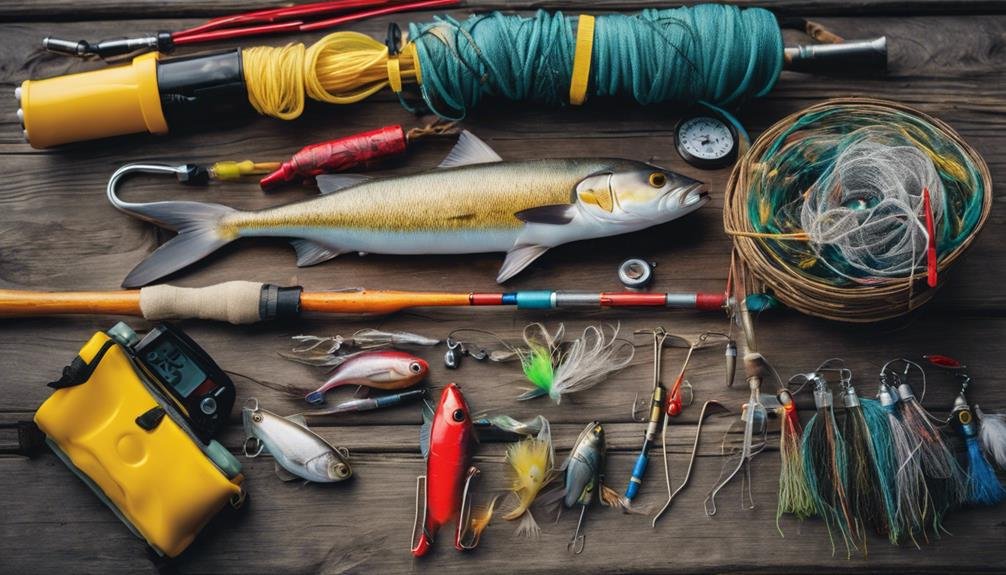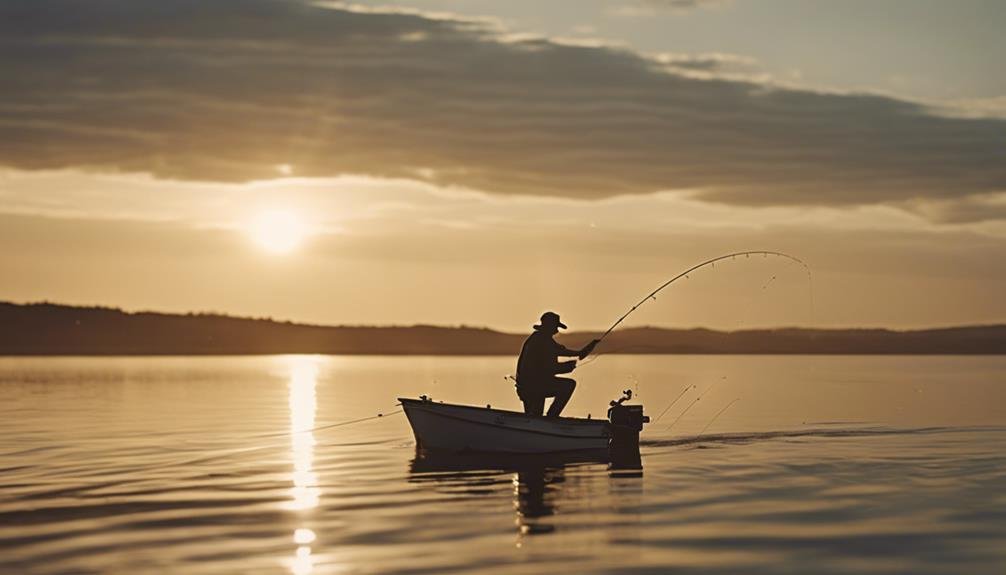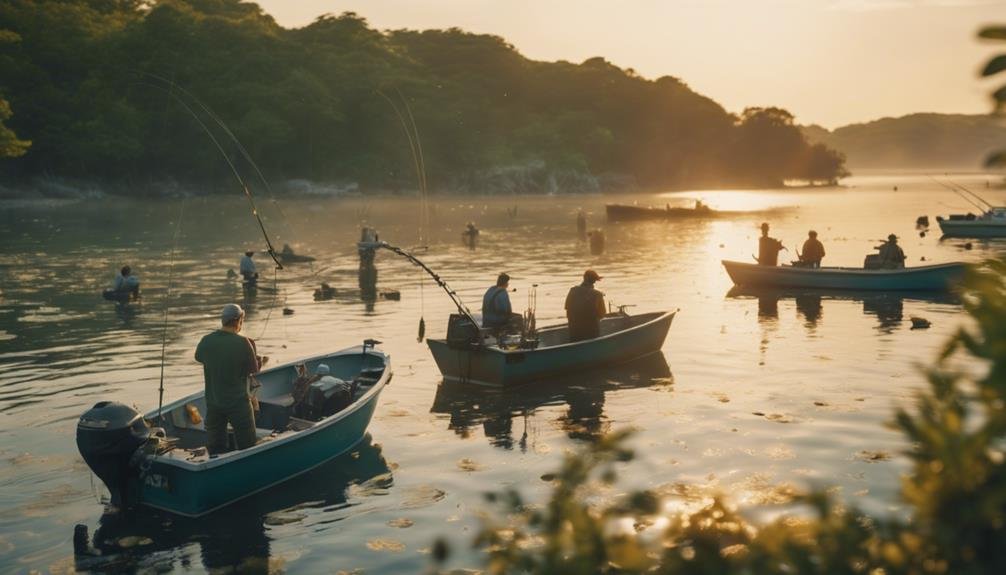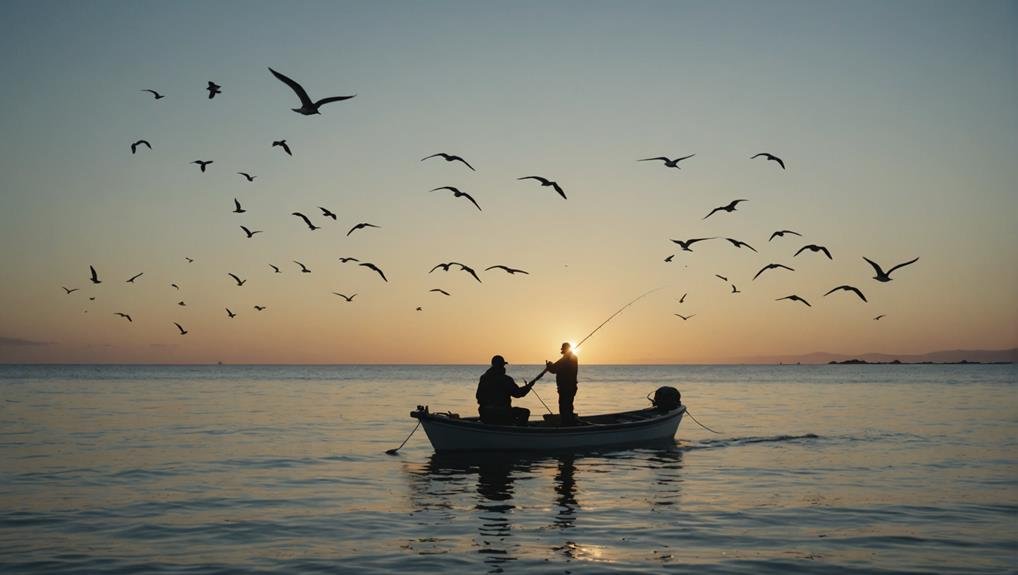When you’re gearing up for fluke fishing along the East Coast, it’s important to know your equipment and techniques to maximize your success. You’ll want to use a 6-7 foot rod paired with a light reel and a 10-30 pound monofilament line to handle the flatfish. But it’s not just about the gear; understanding fluke behavior, seasonal variations, and tidal influences can make all the difference. Have you considered how the right lures, like bucktails or jigs, can greatly improve your catch rate? Let’s explore key strategies to enhance your fluke fishing experience.
Key Takeaways
- For optimal control and sensitivity, use a 6-7 foot rod with a light reel and 10-30 pound monofilament line.
- Select lure sizes and colors that mimic local baitfish, focusing on natural colors in clear water and darker hues in murky conditions.
- Target coastal hotspots with sandy or muddy bottoms, focusing on structures like jetties, bridges, and artificial reefs.
- Pay attention to tidal movements and fishing during incoming tides near natural structures where flukes is most active.
- Stay informed about seasonal regulations and NOAA guidelines to ensure a compliant and sustainable fishing experience.
Essential Gear

When gearing up for fluke fishing, you’ll need a 6-7 foot rod paired with a light conventional or spinning reel. This setup offers the sensitivity and control necessary to detect fluke bites and manage your catch effectively.
Opt for a 10-30 pound monofilament line for your main line. Monofilament is versatile and provides just the right amount of stretch to absorb sudden movements, which is essential when targeting fluke.
Your next consideration should be your fluke rig. Simple rigs like bucktails or jig heads are highly effective for catching flukes. Bucktails mimic the movement of small fish and other prey, attracting flukes with their lifelike action. On the other hand, jig heads allow you to attach various soft plastics or bait, giving you the flexibility to adjust based on the fluke’s preferences that day.
Understanding fluke behavior and their habitat preferences is vital for a successful outing. Flukes often inhabit sandy or muddy bottoms and are known to be ambush predators. Your gear selection should be tailored to these conditions.
Choosing the Right Lures
When choosing the right lures for fluke fishing, consider size and color to mimic the local baitfish. Adjust your lure selections based on the season, as Fluke may respond differently throughout the year.
Experiment with various techniques to find what works best, including using white bucktail jigs or lead head jigs with soft plastic trailers.
Size and Color Selection
Choosing the right size and color for your fluke lures can greatly impact your success out on the water. When fluke fishing, matching the size of your lures to the prevalent baitfish is essential. Typically, lures ranging from 3 to 6 inches work best. These sizes are ideal for mimicking the small fish and squid that fluke commonly prey upon.
Natural colors like white, chartreuse, and silver are excellent choices because they closely resemble the appearance of common fluke prey. These colors work well in clear water, providing a realistic look that Fluke finds hard to resist.
However, don’t overlook the effectiveness of darker colors, such as black and purple, especially in murky or low-light conditions. These colors create a strong silhouette that can stand out in less-than-ideal visibility, making it easier for fluke to spot your lure.
Consider using lures with contrasting colors or patterns to increase their visibility across different water conditions. This can help attract fluke even when the water clarity varies.
Experimenting with different sizes and colors will help you determine what works best in your fishing situation, ensuring you’re always ready to adapt and catch more flukes.
Seasonal Lure Variations
Adapting your lure choice to the season can greatly enhance your success in fluke fishing. In the summer, brightly colored jigs or bucktails can attract summer flounder in warmer waters. Opt for vibrant hues like chartreuse or pink to stand out in clear conditions. Switch to natural-colored lures that mimic local baitfish as fall approaches and fluke migrate. This can yield better results as the fluke becomes more selective.
In spring, smaller lures like spearing rigs or bucktails can be particularly effective when fluke is more active. They match the size of the early-season bait and appeal to hungry fluke. Additionally, scented soft plastic grubs or swimbaits can enhance lure effectiveness, especially in murky or low-visibility conditions.
Another important fishing tip is to adjust the size and weight of your lures based on current strength and water depth. Heavier lures can help you target fluke at greater depths, while lighter ones are suitable for shallower waters.
Here’s a quick reference table to help you choose the right lures for each season:
| Season | Lure Type |
|---|---|
| Summer | Brightly colored jigs |
| Fall | Natural-colored lures |
| Spring | Smaller lures, spearing rigs |
| All | Scented soft plastic grubs |
These seasonal adaptations can significantly enhance your fluke fishing experience.
Effective Lure Techniques
How can you maximize your fluke fishing success by choosing the right lures?
First, opt for jigs with bucktail skirts in white or chartreuse, as these colors are particularly effective in attracting fluke. When flounder fishing, a jig head with soft plastic grubs can mimic natural prey, increasing your chances of landing a catch.
Incorporating squid strips on your hook can provide an additional scent and visual appeal, making it hard for any fluke to resist. Another option to contemplate is using scented artificial baits like Berkley Saltwater Gulp. These baits have a proven track record of attracting fluke due to their strong scent and lifelike appearance.
Don’t stick to one retrieval speed or depth. Varying these can help you determine the fluke response on any given day. Sometimes a slow and steady retrieve works best, while other times a quick, erratic motion will trigger strikes.
Lastly, using teaser hooks in combination with your chosen lures can considerably increase your strike rate. Teasers work by creating additional movement and attracting the fluke’s attention, giving you a better chance of a successful catch.
Techniques for Success

Mastering fluke fishing requires varied bait options, strategic hook setting, and dynamic rod movements to entice strikes. Start with diverse bait choices like live minnows, squid, and artificial grubs. Live minnows are particularly effective because their natural movements attract flukes.
Don’t stick to just one type or color; experiment with combinations to see what the fluke is biting on that day.
When it comes to hooks, using a circle hook can greatly improve your success rate. Circle hooks are designed to set themselves, reducing the risk of gut-hooking the fish. This is especially important in fluke fishing, as these fish strike quickly and aggressively. Make sure you adjust your hook-setting technique depending on the type of hook you’re using.
Keep your bait in motion to trigger a strike. Frequently raising your rod will make your bait appear more lively and enticing to the fluke. Additionally, using teaser hooks can enhance your bait presentation. A teaser hook above your main hook adds extra movement and visual appeal, increasing your chances of a successful catch.
Best Locations
When searching for the best fluke fishing spots, focus on coastal hotspots like bridges, jetties, and wrecks.
Pay attention to tidal influences; flukes often move with the tides to find food.
Also, consider seasonal variations, as water temperature can greatly affect their location.
Coastal Hotspots
You’ll find the best fluke fishing in coastal hotspots with sandy and muddy bottoms near artificial reefs, ledges, bridges, and docks. These areas are key locations because flounder and fluke often relate to structures off the edge. When you’re out on a party boat, dropping your line near these structures is important. Combining the right location and effective techniques can greatly increase your chances of a successful catch.
Coastal hotspots are teeming with fluke, especially during high tides in shallow backwater bays. These shallow coastal bays are perfect for using jig and grub combos to attract flounder and fluke. The artificial reefs and ledges create an ideal environment for these fish to hide and hunt, making them excellent spots to cast your line. Bridges and docks also offer shade and structure, which fluke favor.
Whether you’re drift fishing or anchoring, finding these structures and working your bait effectively is key. If you’re on a party boat, communicate with the captain to position the vessel near these hotspots. Focusing on these prime locations will maximize your chances of landing a trophy fluke.
Tidal Influences
Understanding how tidal influences affect fluke behavior can greatly enhance your fishing success. Tidal movements are essential in determining where flukes are likely to be found. With incoming tides, more baitfish are brought into coastal areas, attracting fluke to feed. This influx of prey means you’ll have better chances of catching fluke during these times.
To maximize your efforts, focus on locations where tidal currents create natural structures like sandbars, ledges, and drop-offs. These features are fluke hotspots because they provide shelter and ambush points for these predatory fish. Flukes are most active during tidal changes, making these periods ideal for targeting them. Timing your fishing trips around these tidal shifts can make a significant difference.
Prime locations include tidal inlets, channels, and estuaries, where water movement concentrates baitfish and fluke. Due to the nutrients carried by the currents, these areas are often teeming with life.
Seasonal Variations
Fluke fishing locations change with the seasons, so knowing the best spots for each time of year is essential. In the spring, you’ll find fluke in shallow waters near sandy bottoms and structures. These areas provide warmth and abundant food, making them ideal for fluke.
As summer rolls in, the East Coast, particularly New Jersey, becomes a hotspot for fluke fishing. Coastal waters and inlets are where you’ll want to cast your line.
In the fall, fluke moves to deeper waters, often near wrecks and reefs. This is when you might need a heavier-pound test line to handle the larger fish and the challenging terrain.
Winter fluke fishing is more specialized and feasible in regions with milder climates. This season, focus on deeper offshore waters where fluke seeks more stable temperatures.
Here’s a quick seasonal guide for the best fluke fishing locations:
- Spring: Shallow waters near sandy bottoms and structures.
- Summer: Coastal waters and inlets along the East Coast, especially New Jersey.
- Fall: Deeper waters near wrecks and reefs.
- Winter: Deeper offshore waters in milder climate areas.
Understanding these seasonal variations will enhance your fluke fishing success.
Seasonal Tips

As fluke fishing season kicks off in April, staying informed about state-specific regulations and NOAA guidelines is important to guarantee a successful and compliant fishing experience. Each state, such as New Jersey, has its own set of rules, including minimum size requirements and daily bag limits for fluke fishing. Double-check these regulations before you hit the waters to avoid any legal issues.
When you’re out on the East Coast targeting fluke, using a three-way swivel setup can greatly improve your chances of a productive day. This rig helps maintain your bait’s ideal position near the bottom, where fluke typically lurks. Once you feel a bite, set the hook quickly but gently to secure your catch. Fluke has a tendency to nibble before fully committing, so timing is important.
It is equally essential to stay updated on federal recreational measures for summer flounder fishing through NOAA. Regulations can change annually, so make it a habit to review the latest information before each trip. By staying informed and prepared, you’ll enhance your fishing experience and contribute to sustainable fishing practices.
Apparel and Accessories
The right apparel and accessories can make all the difference when gearing up for a fluke fishing trip. You’ll want gear that’s both important and functional, especially when you’re dealing with the challenges of deep-water fishing.
Here are some essential items to think about:
- Shirts and Hoodies: Choose long-sleeve shirts and hoodies made from breathable, moisture-wicking fabrics. These keep you cool under the sun and protect against the elements.
- Short-Sleeve T-Shirts: Short-sleeved t-shirts made from quick-dry materials are ideal for warmer days. They offer comfort without compromising on performance.
- Hats: A good hat is vital for shielding your face and eyes from the sun. Look for wide-brimmed hats or caps with UV protection.
- Sweatshirts: Early mornings or late afternoons can get chilly, especially on the water. A durable sweatshirt can keep you warm without being too bulky.
Conclusion
So, you’re ready to get out there and catch some fluke! With the right gear, lures, and techniques, you’ll increase your chances of success.
Remember to focus on tidal influences and prime coastal hotspots, and keep an eye on seasonal changes.
Stay adaptable and prepared with the right apparel and accessories.
By following these tips, you’ll be well on your way to a productive and enjoyable fluke fishing experience.
FAQs
What is fluke fishing, and why is it popular?
Fluke fishing targets a species of flatfish known as summer flounder, commonly called “fluke.” It is popular because flukes are abundant in coastal waters, are fun to catch, and provide delicious table fare. They are known for their aggressive feeding habits and unique shape, which makes them a sought-after species for anglers.
What are the best locations to catch fluke?
Fluke are commonly found in:
- Inlets and Channels: Fluke often congregate in areas with strong tidal currents, where they can ambush prey.
- Sandy Bottoms: They prefer sandy or muddy bottoms where they can bury themselves and wait for prey.
- Near Structures: Look for fluke near underwater structures like jetties, reefs, and wrecks, which provide cover and attract baitfish.
- Shallow Bays and Estuaries: These areas are especially productive during the warmer months when fluke moves into shallow waters to feed.
What type of gear do I need for fluke fishing?
For fluke fishing, you’ll need:
- Rod and Reel: A medium to medium-heavy action rod paired with a spinning or conventional reel is ideal. The reel should have a smooth drag system, as fluke can make strong, sudden runs.
- Line: For sensitivity and strength, use a braided line in the 15-30 lb test range, with a fluorocarbon leader to reduce visibility.
- Hooks: Wide-gap hooks in sizes 2/0 to 4/0 work well for holding larger baits like squid or minnows.
- Sinkers: Depending on the current and depth, use 1 to 8 ounces of sinkers to keep your bait near the bottom.
- Rigs: The most common rig for fluke fishing is the fluke rig or fish finder rig, often paired with a teaser or bucktail to attract fluke.
What are the best baits for fluke fishing?
Fluke are opportunistic feeders, and effective baits include:
- Live Bait: Minnows, killifish, and small mullet are excellent live baits that mimic the natural prey of fluke.
- Strip Baits: Strips of squid, sea robin, or bluefish are popular because they stay on the hook well and create enticing movement.
- Soft Plastics: Gulp! Swimming mullets or shrimp imitations are highly effective, especially when jigged near the bottom.
- Bucktails: Bucktail jigs tipped with a strip bait or soft plastic are a go-to for many fluke anglers. The bucktail’s movement and the bait’s scent are irresistible to fluke.
What are some effective techniques for fluke fishing?
Effective techniques for fluke fishing include:
- Drift Fishing: Drift your bait along the bottom with the current. This technique covers more ground and allows you to locate actively feeding fluke.
- Jigging: Bounce a bucktail jig or weighted soft plastic along the bottom. The erratic movement of the jig mimics wounded prey, enticing fluke to strike.
- Trolling: Use a slow trolling speed to pull your bait or lure along the bottom, particularly in channels and along drop-offs.
- Bounce and Drag: Slowly bounce your bait off the bottom, then drag it a few feet before jumping again. This technique keeps the bait in the strike zone longer.
How can I improve my chances of catching a fluke?
To improve your chances of catching a fluke:
- Fish with the Tide: Fluke is more active during moving tides, particularly incoming and outgoing tides, which bring baitfish into their feeding areas.
- Use a Teaser: Adding a small teaser, such as a bucktail or soft plastic, can attract more strikes a few inches above your main bait.
- Vary Your Presentation: Experiment with different retrieval speeds, jigging actions, and bait types to see what the fluke responds to on any given day.
- Cover Ground: Keep moving until you find where the flukes are concentrated. Drifting or trolling can help you cover more areas.
- Focus on Structure: Flukes often hide near underwater structures, targeting areas with drop-offs, rocks, and wrecks.
What are some safety tips for fluke fishing?
Safety is important when fluke fishing, especially in coastal and offshore waters:
- Check the Weather: Always check the weather forecast before heading out, and avoid fishing in rough seas or during storms.
- Wear a Life Jacket: When fishing from a boat, always wear a life jacket or have one readily accessible.
- Be Aware of Tides: Know the tide schedule and be mindful of rising or falling tides, especially when fishing near inlets or jetties.
- Use Sun Protection: Wear sunscreen, sunglasses, and a hat to protect yourself from sun exposure during long days on the water.
- Handle Fish with Care: Use a net to land flukes and handle them carefully to avoid injury from their sharp teeth and gill covers.
By following these tips and techniques, you can increase your success in fluke fishing and enjoy a rewarding experience on the water. Whether you’re a beginner or a seasoned angler, fluke fishing offers an exciting challenge and the opportunity to catch delicious, sought-after fish.

